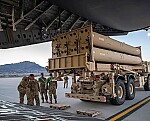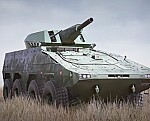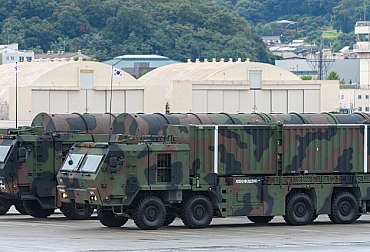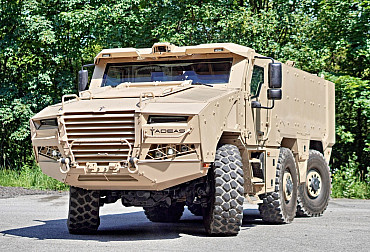Czech DITA howitzers in Ukraine continue to demonstrate the importance of technological superiority to the Russians
Ukrainian soldiers report positive experiences with the Czech-made 155mm self-propelled howitzer DITA, highlighting its advanced features and effectiveness against Russian forces. The system developed by Excalibur Army has been introduced into the arsenal of various Ukrainian units, including the Azov Brigade of the National Guard, the 3rd "Spartan" Brigade and the State Border Service. Deliveries of the howitzers started with Dutch financial support in mid-2024.

Ukrainian soldiers praise the high level of automation of the DITA self-propelled howitzer, which allows the system to be operated by a crew of only two – the driver and the commander. The system’s automation uses an advanced on-board control system that calculates firing parameters and takes care of automatic reloading and targeting, which significantly reduces the time needed to prepare and execute firing missions. The Azov Brigade, for example, said the howitzer can transition from drive to fire mode in about one minute and can leave its position just as quickly after firing, greatly increasing survivability in a dynamic combat environment. The system's ability to conduct fire in MRSI (Multiple Round Simultaneous Impact) mode, where multiple rounds hit the target almost simultaneously, was also highlighted as a key advantage.
The mobility of the DITA artillery system, which is installed on a proven Tatra 8x8 chassis, was also positively assessed. This allows for a quick change of position in different terrains, which is one of the decisive factors on the Ukrainian battlefield, where the fighting takes place in variable terrain. With a range of up to 39 kilometres when using conventional three-burst rounds and a rate of fire of five to six rounds per minute, Ukrainian artillerymen highlight the DITA system's ability to engage distant targets while staying out of range of virtually all enemy gun systems. The extended range and high mobility, and thus greater flexibility and safety, were significant improvements over the towed guns previously used by some units.
The Czech DITA howitzers were most recently praised by members of the 13th "Khartiya" Brigade in a video by the Ukrainian news program TSNWeek, where they mentioned a particularly interesting feature regarding multi-shot simultaneous fire: "(The DITA) can fire three shots from different angles with varied targeting. However, the arrival of these two or three shots is almost simultaneous, with a five-second interval." The result is that the enemy has no idea who is actually firing against him and from where.
Video: Czech DITA howitzers were recently praised by members of the 13th "Chartija" Brigade / YouTube
The DITA self-propelled howitzer has a 155mm gun with a barrel length of 45 calibre, which is shorter than, for example, the French 155mm CAESAR howitzer or the Czech 155mm MORANA howitzer, which have a barrel length of 52 calibre. The barrel length has a direct effect on the muzzle velocity and thus on the range. However, the maximum range of the DITA is approximately 39 kilometres, which makes the Czech self-propelled howitzer reliably outperforms even the most powerful Russian system in its category, the 152 mm calibre 2S19 Msta-S tracked howitzer with a range of 29-36 km.
A repeatedly mentioned practical benefit of the DITA system is also the Ukrainian language support in the howitzer's electronics and software, which greatly facilitates training and operation of the system. As we have mentioned in the past, the Azov Brigade, which received its first DITA systems in November 2024, published a video review in early January 2025 describing the Czech howitzers as a "significant enhancement" to its artillery capabilities. A commander from the 3rd "Spartan" Brigade, known as "Marly", also confirmed the successful use of howitzers in combat, although specific details of deployment remain limited for obvious reasons. In any case, Ukrainian soldiers have found the DITA howitzer to be a reliable, effective and efficient addition to their arsenal, with its rapid deployment, accuracy and mobility proving very useful in ongoing operations.

To date, there is no clear evidence from official Ukrainian, Dutch or Czech sources to confirm that a single DITA howitzer was lost. Thus, without photographic evidence, official reports, or verification from reliable military analysts (such as Oryx, a server that tracks visually confirmed losses), any claims made to date on social media accounts are just unconfirmed speculation.
In total, Oryx documents more than 735 towed and self-propelled Ukrainian howitzers destroyed, damaged, or captured by the Russians since February 2022, an average of 20 per month. The six-month deployment of Czech DITA howitzers in Ukraine without a single loss is thus an indirect confirmation of the quality and reliability of this system. The aforementioned automation and mobility naturally reduce the weapon's vulnerability to anti-battery fire, especially when compared to older systems such as the Soviet-era 2S1 Gvozdika or towed guns.
The exact total number of DITA howitzers delivered to Ukrainian forces is also not definitively clear from publicly available sources. It is known, however, that in February 2024 the Dutch Ministry of Defence placed an initial order with Excalibur Army for nine DITA systems, which were delivered within an unprecedented timeframe: by the summer of 2024. Subsequently, in October 2024, the Netherlands announced a further order for six units, with deliveries expected by 2025. It can therefore be assumed that a total of up to fifteen of these howitzers are now operating in Ukraine.










